Janusz Groszkowski (1898-1984)
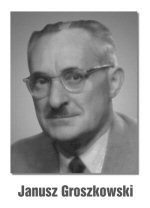
Radio and electronics engineer. One of the first graduates of the Warsaw University of Technology (WUT) in 1919 and the Military Academy for communications officers in Paris (1922). As such, he was a lecturer on radio engineering in military schools.
In 1928 he received a doctorate degree for his thesis on radio wave stability compensation method (Metoda kompensacyjna kontroli stałości fali) and was appointed Chair of Radio Engineering at the WUT Faculty of Electrical Engineering. In 1929 he was appointed associate professor and subsequently, professor in 1935.
In 1928 he initiated the establishment of the first radio engineering institute in the country (later Institute of Telecommunications), which he directed since 1934. During occupation years, he was the underground lecturer at University. Simultaneously to his educational career, he was a soldier of the Polish Home Army, in which he managed to decipher missile navigating systems of V-2 rockets. In 1945 he founded the WUT Faculty of Electrical Engineering (later Faculty of Communications), where he chaired the Radiolocation Institute until retirement in 1968. He organized the first Polish Academy of Sciences (PAN) research units: the Electronics Unit and The Institute of Fundamental Technological Research in Science (IPPT), to which the unit was later incorporated. In 1961-1963 he was appointed Director of IPPT PAN.
Janusz Groszkowiski was an outstanding expert in high vacuum measurement. He gained international recognition for his work on ionizing heads for low-pressure measurement. Author of 16 patents and 361 scientific papers, also books (Techinika wysokiej próżni, 1972). Supervisor of 33 dissertations.
Since 1936, he was a member of Akademia Nauk Technicznych (Academy of Technical Sciences), since 1949 – Towarzystwo Naukowe Warszawskie (Warsaw Scientific Society), since 1952 he was a member of the PAN, since 1957 – its vice-president, and then in 1962-1971 its president. He resigned from being a member of the Sejm (lower house of the Polish Parliament) of the PRL - People’s Republic of Poland, and vice-president of Rada Państwa (the State Council), as an act of protest against progressing political repression in 1976. Member of 6 foreign academies of sciences (Czechoslovakia, Hungary, the Soviet Union, Romani, Bulgaria and Cuba) and honorary member of many associations. Laureate of the First Class State Award (1951, 1955, 1968, 1979). He was conferred the degree of honorary doctor (doctor honoris causa), at: Warsaw, Gdansk, and Łódź Universities of Technology. Holder of state awards: the Gold Cross of the Virtuti Militari War Order, Commander's Cross of the Order of Polonia Restituta (twice), Officer's Cross of the Order of Polonia Restituta.
The Military Communication Institute credited professor Groszkowski’s scientific achievements, giving the Institute his name.
Aleksander Krupkowski (1894-1978)
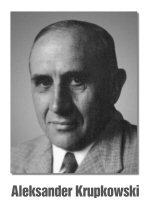
He graduated from the Faculty of Metallurgy at Peter the Great St. Petersburg Polytechnic University in 1917. After returning to Poland, he started working in secondary education, and then as a teaching assistant at the Faculty of Metal Science at the Warsaw University of Technology. In 1928, he received his doctorate; in 1930, the degree of venia legendi, (corresponding to the contemporary Polish habilitation degree – a post-doctoral academic degree) and was appointed associate professor, and then, in 1939, professor. Also in 1930, he was appointed professor at the AGH University of Science and Technology and in 1934, member of the Academy of Technical Sciences. During the Second World War, together with other professors from Kraków’s universities, he was deported to Sachsenhausen concentration camp, and returned in 1940. Following the establishment of the Polish Academy of Sciences (PAN) in 1952, he also became its member. He was appointed Head of the Metals Department of PAN, founded upon his initiative and based in Cracow, and since 1953, operated as part of the Institute of Fundamental Technological Research of the Polish Academy of Sciences (IPPT PAN). In 1969, the department started operating as an independent research centre of the PAN and, subsequently, was given the name of A. Krupkowski Institute of Metallurgy and Metal Engineering of the Polish Academy of Sciences.
Aleksander Krupkowski’s high versatility allowed for developing his interests in a vast area of metal science: thermodynamics of basic metal production and refining processes; the kinetics of oxidation and reduction reactions in oxides; metal rectification: phase transitions in alloys, plastic deformation processes, and mechanical properties. He succeeded in achieving outstanding results in all these areas of interest.
The author of about 300 papers published in Poland and abroad, including two very significant monographs: Zasady termodynamiki i ich zastosowanie w metalurigii i metaloznawstwie (Principles of thermodynamics and their application in metallurgy and metal science, 1958) and Podstawowe zagadnienia teorii procesów metalurgicznych (Basic issues of the theory of metallurgic processes, 1974). Despite his lack of commitment in the political life of the communist PRL (which to many guaranteed career successes), he was awarded highest state prizes for his contribution to science – he was a three-time laureate of the First Class State Award and was conferred the degree of honorary doctor (doctor honoris causa), at the Freiberg University of Mining and Technology.
Ignacy Malecki (1912-2004)
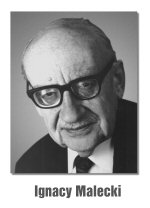
Graduate of the Faculty of Electrical Engineering of the Warsaw University of Technology – he received the diploma from Prof. J. Groszkowski in 1935. In pursuit of his academic interests, he furthered his studies at the Hertz Institute in Berlin. In 1941, he became doctor of the underground Faculty of Architecture, organized by the Warsaw University of Technology. In 1943, he received the degree of venia legendi (corresponding to the contemporary Polish habilitation degree – a post-doctoral academic degree). Later in 1946 – he became Associate Professor and in 1952 – Professor at the same university. A corresponding member of the Polish Academy of Sciences (PAN) since 1954, and a member since 1958.
Member of the PAN Praesidium, Deputy Secretary of Research (1961-1968), an honorary member of many associations and federations (e.g. ASA, FASE, ISCU). In 1936 he co-established a laboratory for the Polish Radio, where he developed a functional and acoustic design of the Central Broadcasting Station.
After the war, he carried out acoustic projects in the rebuilt areas of Sejm and National Theatre. He founded the Department of Applied Electrical Engineering and Acoustics, Faculty of Electrical Engineering of the Gdansk University of Technology. 1951-1969 Head of the Department of Electroacoustics, first Dean of the Faculty of Communications, then Vice-Rector of the Warsaw University of Technology. Organizer of the Department of Vibration Research (1951), one of the four core departments which formed the Institute of Fundamental Technological Research (IPPT), established in 1952. First Director of IPPT (1953-1962; and later 1973-1983).
Pioneer of acoustics as an interdisciplinary science – integrating building and architecture acoustics, audioacoustics, electroacoustics, hydroacoustics, ultrasound, physical and quantum acoustics. In later years, the Professor extended his academic pursuit in the research of acoustic emission.
He authored 11 monographs and c. 230 publications, of which Physical Foundations of Technical Acoustics deserves special attention. This textbook was published by Pergamon Press, Oxford (1969), and valued by students in many countries.
Supervisor of 25 doctoral dissertations. Head of the UNESCO Department of Science Policy in Paris (1969-1972). Organizer of the Acoustics Committee of the Polish Academy of Sciences, initiator of the establishment of the Science Committee of the Polish Academy of Sciences. Honorary Doctor (doctor honoris causa) at: Budapest University of Technology, AGH University of Science and Technology in Cracow and Gdańsk University of Technology. Winner of State Awards and numerous distinctions.
Witold Nowacki (1911-1986)

Graduate of Gdańsk University of Technology (1934); a construction engineer. He designed port structures in Gdynia and built an airframe factory in Mielec. He spent the war in an Oflag prisoner-of-war camp, where he devoted his time to preparing the theses for his later dissertation and habilitation degree, which he received just after the war in September-December 1945, from the Warsaw University of Technology. Since 1945, at the Gdańsk University of Technology: Associate Professor (1947), Head of the Structural Mechanics Department, Dean of the Faculty of Civil Engineering (1947-1949) and Vice-Rector (1949-1952). In 1952-1955, he headed the Department of Structural Mechanics at the Faculty of Industrial Engineering of the Warsaw University of Technology. In 1955-1981, he joined the University of Warsaw, where he took up the position of: head of the Department of Elasticity and Viscosity Theory (1955-1969), the Department of Solid Mechanics (1969-1981) and director of the Institute of Mechanics (1969-1978). Since 1952, he was a corresponding member, and since 1956 - a member of the Polish Academy of Sciences and Secretary of Research of the Department IV of Technical Sciences (1956-1968). At the Polish Academy of Sciences, he held the following positions: Secretary of Research (1956-1968), vice-president (1969-1977) and president (1978-1980). He was also one of the founding fathers of the IPPT: founder and manager of the Laboratory of Theory of Elasticity, mentor of the Department of Theory of Continuous Media. For many years, he chaired the IPPT Scientific Council.
Creator of the Polish school of thermal elasticity and asymmetrical elasticity and initiator of research in the theory of interconnected fields. He authored over 200 publications, including several monographs, which were translated into many languages. He is also the author of well-known academic textbooks, reprinted in Poland and abroad. He supervised 28 dissertations. Honorary doctor (doctor honoris causa) of ten universities and a member of three foreign academies of sciences. Honoured with the highest state awards, he was a two-time laureate of the First Class State Award (1955 and 1964).
Wacław Olszak (1902-1980)
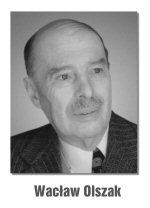
Graduate of the Vienna University of Technology in Civil and Water Engineering (1925). He furthered his studies at the Faculte des Sciences at Paris University (1926-1927). Doctorates: 1933, at the Vienna University of Technology – a dissertation on reinforced concrete structures, in 1934, at the Warsaw University of Technology – a dissertation on the theory of plasticity (under the supervision of M.T. Hubert). Habilitated in 1937 at the AGH University of Science and Technology on statics and dynamics of anti-aircraft structures. In 1946, he became associate professor, and head of the Department of Strength of Materials at the AGH University of Science and Technology in Cracow. He organized research in the field of prestressed structures and applied mechanics at two universities – the AGH and the newly-established Cracow University of Technology. In 1952, he started his cooperation with the Warsaw University of Technology and the then-establishing Polish Academy of Sciences and created the first Department of Theory of Elasticity and Plasticity and the Department of the Mechanics of Continuous Media, thus creating solid foundations for the IPPT, which he directed until 1970.
In 1954, he became a corresponding member, and in 1956, a member of the Polish Academy of Sciences. Director of IPPT (1963-1970), Secretary to the 4th Department of the Polish Academy of Sciences (1957-1960), member of the PAN Presidium, co-organizer and rector of the International Centre for the Mechanical Sciences in Udine (CISM) (1970-1980). Creator of the world-famous Polish school of theory of elasticity. His scientific research included: theory of elasticity; theory of prestressed structures; rheology.
Author of 290 scientific papers, 10 monographs, editor of 6. Co-founder and member of the board of the RILEM and IASS, IUTAM and IABSE. Co-founder of the Archiwum Mechaniki Stosowanej (Archives of Applied Mechanics) and Rozprawy Inżynierskie (Engineering Theses), 1949. Member of editorial committees of many magazines, organizer of international meetings. He initiated the Polish Conference of Solid Mechanics. Great international authority, propagator of the achievements of Polish mechanics abroad. Supervisor of 16 doctoral students. Honorary doctor (doctor honoris causa) of 9 domestic and foreign universities. Member of 17 foreign academies of sciences. Winner of many state and international awards, a two-time winner of the Polish State Award.
Zbigniew Wasiutyński (1902-1974)
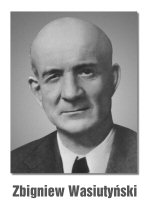
He graduated from the Faculty of Civil Engineering of the Warsaw University of Technology in 1926, followed by a complimentary study at the Faculty of Mathematics and Natural Sciences at the University of Warsaw (1927-1928) and at the Faculte des Sciences of the University of Paris (1928-1924). Since 1924, he worked at the Warsaw University of Technology, where he received a doctoral degree in 1934. Due to the outbreak of war, he published a thesis on structural durability at the underground Warsaw University of Technology in 1939, for which he received his habilitation degree in 1943. In 1939, he participated in the combats of General Franciszek Kleeberg’s armed forces. During the occupation, he was a member of the Home Army and took part in underground education.
He was the author of many bridge and other construction designs, and lecturer of mathematics, mechanics and bridge engineering. He conducted research in various fields: bridge engineering, measurement methods, construction optimisation, architecture, philosophical issues (aesthetics, praxeology), theory of communication. He authored 207 publications and 12 books. He supervised 14 doctoral students. In 1951-1968 he chaired the Faculty of Bridge Design at the Warsaw University of Technology. In 1953, he organized the Laboratory of Strength Modelling at the IPPT PAN, which he also directed until 1973. A corresponding member (1958) and member of the PAN (1966). In 1969-1971 he chaired the PAN Committee of Civil Engineering. He was a member of scientific councils of a few research institutions, adviser to the Ministry of Communication and Ministry of Municipal Affairs and Praesidium of the Scientific Council in Warsaw. He was an extraordinarily versatile and prolific academic whose posthumous publication of the selection of his works covered five volumes in seven different specializations. Professor Wasiutyński was honoured with prestigious national awards and prizes, including the First Class State Award.















